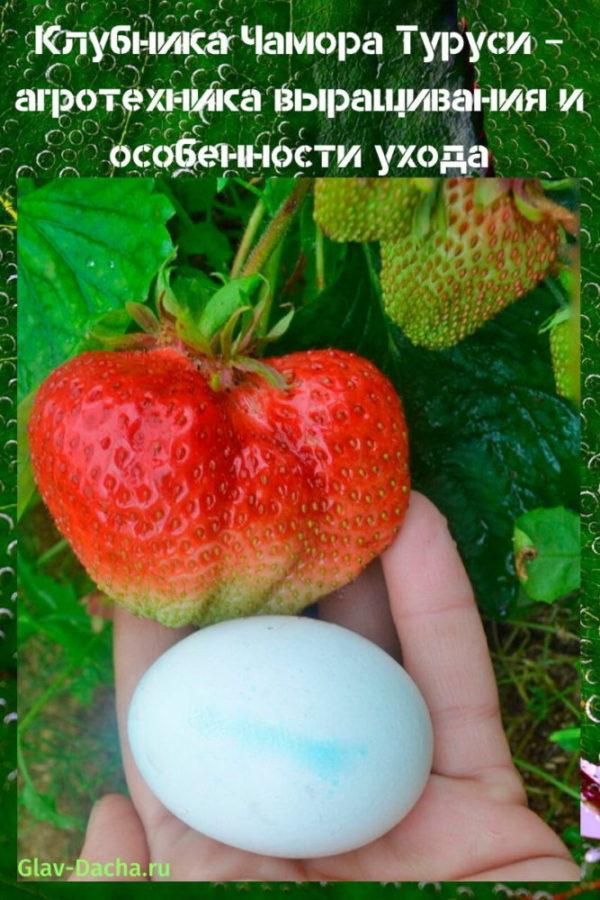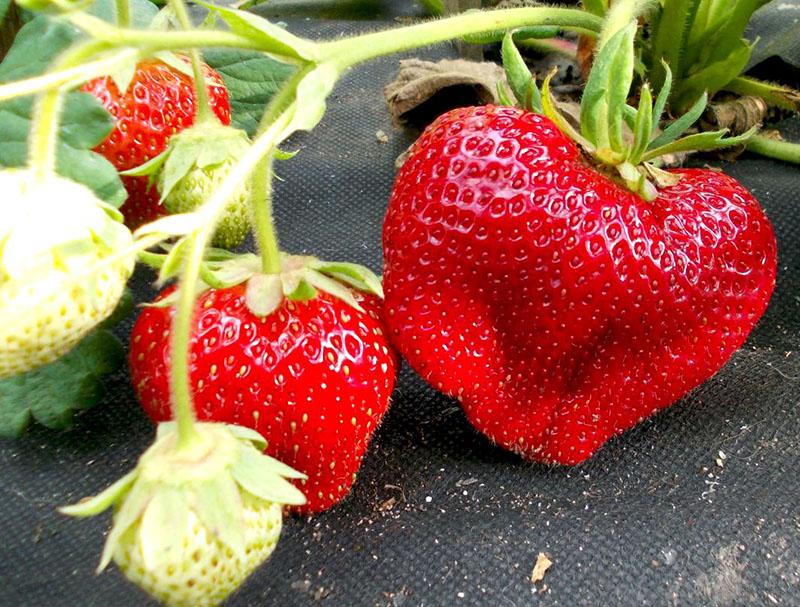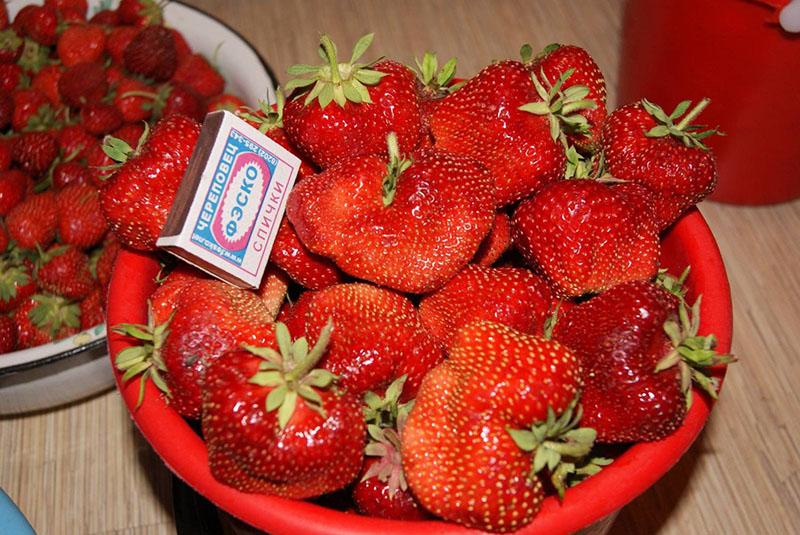Strawberries Chamora Turusi - cultivation techniques and care features
 Chamora Turusi is one of the most popular medium-late large-fruited strawberry varieties, which is highly valued by gardeners. Chamora Turusi strawberries, the cultivation technique of which is very simple, has become widespread due to unpretentious care, high resistance to frost and many diseases, high yield and excellent taste characteristics.
Chamora Turusi is one of the most popular medium-late large-fruited strawberry varieties, which is highly valued by gardeners. Chamora Turusi strawberries, the cultivation technique of which is very simple, has become widespread due to unpretentious care, high resistance to frost and many diseases, high yield and excellent taste characteristics.
Chamora Turusi - variety description

Strawberry Chamora Turusi:
- has strong, strong and tall bushes with lush and dense, dark green foliage;
- forms multiple dense antennae;
- quickly adapts to short daylight hours;
- it is highly frost-resistant, but does not tolerate drought;
- resistant to powdery mildew, but needs additional protection against fungal diseases;
- fruits are large, rounded or conical, rich, bright color with a strawberry aroma;
- the average weight of berries is up to 60-150 g;
- in the absence of feeding, the weight of the berries is 25-30 g;
- yield indicators reach 1.4-1.7 kg per bush;
- fruiting duration - up to 7-12 years;
- most often fruiting lasts 6-7 years, after which the bushes need to be transplanted into prepared soil;
- the first fruits ripen in the second decade of June, the maximum yield can be harvested at the end of the month.
 Agrotechnics of growing strawberries of Chamora Turusi is not complicated, but some peculiarities must be taken into account.
Agrotechnics of growing strawberries of Chamora Turusi is not complicated, but some peculiarities must be taken into account.
Landing scheme and timing
 Strawberries of the Chamora Turusi variety should be planted in the open part of the personal plot, which is illuminated by sunlight for at least 12 hours a day. In order to provide the necessary lighting, the beds are planted in the direction from north to south. Strawberry bushes should not be planted in shaded areas - due to this, the size of the berries will be much smaller.
Strawberries of the Chamora Turusi variety should be planted in the open part of the personal plot, which is illuminated by sunlight for at least 12 hours a day. In order to provide the necessary lighting, the beds are planted in the direction from north to south. Strawberry bushes should not be planted in shaded areas - due to this, the size of the berries will be much smaller.
Basic landing rules for Chamora Turusi:
- For planting strawberries, it is better to choose flat areas where it used to grow beans, garlic, carrots. The soil after tomatoes, potatoes, cucumbers or cabbage is considered unsuitable.
- 4 weeks before planting, the soil must be prepared - loosened, remove weeds, feed with organic or mineral fertilizers.

- Strawberry seedlings are planted in both spring and autumn. The most suitable period is considered to be from mid-April to mid-May. In autumn, Chamora Turusi is planted in early September.

Chamora Turusi has large, massive shrubs with lush foliage that require a lot of space. Therefore, the bushes are best planted at a distance of at least 40-60 cm.
The basic rule for planting strawberries is that no more than 3-4 bushes should be planted on one square meter of the plot.
To plant the plant, dig holes large enough to accommodate the strawberry roots. After that, pour them with water and place a seedling inside that has 4-5 green leaves. Lightly press the roots of the plant with your fingers and sprinkle with soil on top.
Strawberry Chamora Turusi: cultivation techniques
 Agrotechnics of growing strawberries of Chamora Turusi is light and simple, so this variety is perfect even for novice gardeners.Despite its high resistance to many diseases and pests, the plant needs additional protection.
Agrotechnics of growing strawberries of Chamora Turusi is light and simple, so this variety is perfect even for novice gardeners.Despite its high resistance to many diseases and pests, the plant needs additional protection.
When growing strawberries of Chamora Turusi, special attention should be paid to timely feeding, since the level of its yield and the size of the fruits depend on this.
Watering features
 Strawberry Chamora Turusi belongs to moisture-loving plants that do not tolerate drought. It needs to be watered at least once every 3-4 days. To maintain the required moisture for a long time, a layer of sawdust or other mulch is poured.
Strawberry Chamora Turusi belongs to moisture-loving plants that do not tolerate drought. It needs to be watered at least once every 3-4 days. To maintain the required moisture for a long time, a layer of sawdust or other mulch is poured.
During the first 15 days after planting, young plants should be watered twice a day, pouring at least 500 ml of water on each plant.
 It is better to use drip irrigation before flowering, after which you can water from a watering can. This must be done in such a way that the soil is moistened 20-23 cm deep.
It is better to use drip irrigation before flowering, after which you can water from a watering can. This must be done in such a way that the soil is moistened 20-23 cm deep.
Protection against diseases and pests
 In case of violation of the agricultural technology of growing strawberries of Chamora Turusi, the risk of infection with various diseases and the appearance of pests increases.
In case of violation of the agricultural technology of growing strawberries of Chamora Turusi, the risk of infection with various diseases and the appearance of pests increases.
With the development of gray rot, which manifests itself as dark gray spots on the sheets, an iodine solution is used - 10 ml per 20 liters of water. You can also use a solution of dry mustard powder made from 200 g of this product and 2 buckets of water.
Reddened or yellowed strawberry leaves indicate the development of verticillium. With this disease, folk remedies are powerless, chemicals are used - Benorad, Fundazol.
Feeding strawberries
 Competent and timely feeding of Chamora Turusi strawberries provides a bountiful harvest of juicy, sweet berries. For this purpose, nitrogen-containing fertilizers are used - but they are used in minimal quantities, since the abundance of nitrogen accelerates the growth of green foliage, but not berries. It is best to use natural, organic fertilizers before the first green leaves appear.
Competent and timely feeding of Chamora Turusi strawberries provides a bountiful harvest of juicy, sweet berries. For this purpose, nitrogen-containing fertilizers are used - but they are used in minimal quantities, since the abundance of nitrogen accelerates the growth of green foliage, but not berries. It is best to use natural, organic fertilizers before the first green leaves appear.
Fertilization:
- peat and humus - 5-7 kg per 1 meter of land;
- humus with wood ash - 2 buckets per 1 meter;
- nitroammofoska - 2 tablespoons per bucket of water, used after the leaves appear;
- urea - 50 ml per 1 liter of water.
When ovaries appear on the bushes, it is necessary to feed them with potassium nitrate. The working solution is prepared from 2 tablespoons and a bucket of clean water.
Instead of saltpeter, you can use wood ash - dilute 2 tablespoons of the product in 1 liter of water, leave to infuse for 24 hours, then strain through cheesecloth and use for watering strawberry bushes.
 Chamora Turusi is a popular variety of large-fruited strawberries with high yields and good taste. Due to its unpretentious cultivation and disease resistance, this variety gives a rich, plentiful harvest even for novice gardeners.
Chamora Turusi is a popular variety of large-fruited strawberries with high yields and good taste. Due to its unpretentious cultivation and disease resistance, this variety gives a rich, plentiful harvest even for novice gardeners.